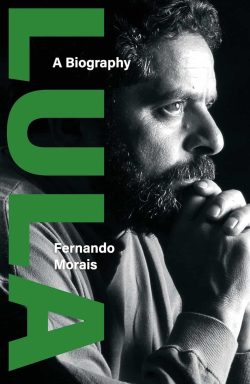Fernando Morais’s biography of President Luis Inácio Lula da Silva, “Lula,” Brazil’s first working-class president, is a primer on modern Brazilian history. Lula, arguably the most well-known Brazilian political figure, is a giant. Barack Obama famously called him “the most popular politician on Earth,” adding “this is my man, right here!” Counting cumulative votes across elections, Lula has received among the greatest number of votes of any president in history. In his book, Morais traces Lula’s story from his childhood in abject poverty and beginning to work as an 8-year-old, to union leader of the largest car manufacturing hub in the region, to cofounder of the Workers’ Party (PT). This approach to Lula’s life is a common one. Another biography, for example, traces his unlikely rise, against all odds, from a metalworker and “fourth grade-educated man of the most humble origins” to president.1John French, Lula and His Politics of Cunning: From Metalworker to President of Brazil (Chapel Hill: University of North Carolina Press, 2020), 1. Morais follows a similar trajectory, emphasizing the transformation of someone who “hated politics and whoever likes politics” into an international political phenomenon.2Fernando Morais, Lula: A Biography, Volume 1 (New York: Verso Books, 2024).
Yet, the more pressing political questions are ones about the substance of Lula’s policies, their social and economic impacts, and how to situate them in the broader history of Brazil. This line of inquiry is also attuned to transformation, but of another kind: how Lula went from a candidate known as propoor and prounion to one who developed a particular political style as he steered increasingly toward the center. For all it offers as a useful introduction to key events in Lula’s life, Morais’s conventional take leaves out the fuller story of Lula and his party in the context of a more complex political landscape.
First published in Portuguese in 2021 by Companhia das Letras, the 2024 English edition was published by Verso Books and translated by Brian Meir. The book’s chapters are organized according to newspaper-style headings. The writing is accessible and often captivating, a style Morais has skillfully developed in his nearly five-decade journalism career. Morais conducted interviews with Lula while flying around the world, drawing on over twenty hours of interviews on planes to write the book. We learn that Lula does not sleep much on planes—one of dozens of meticulous details Morais includes about Lula and the characters surrounding him from his early life to his imprisonment. The list of people he interviewed is similarly impressive, but does not venture far beyond allies. Reading reproductions of Lula’s letters in his curly handwriting, one can almost hear his raspy voice, his palavrões (curse words), and jokes, capturing the charisma for which Lula is so well known.
Critically, and unsurprisingly given the immensity of Lula’s life, the first volume focuses on two specific slices. Though vital parts of Lula’s life, the selection of these episodes frames Morais’s story. The first half focuses on Operation Car Wash (an anticorruption probe that targeted Lula and the PT, among others, leading to his imprisonment) and attacks from the press and Sergio Moro (the judge who ordered Lula’s sentence and later became Minister of Justice and Public Security under Jair Bolsonaro).3Operation Car Wash (lava jato) was a corruption investigation that led to unprecedented charges against numerous politicians, beginning with their involvement in the state-run oil company Petrobras. The most high-profile charges were made against Lula, who as a result was imprisoned and barred from running from office in 2018, making way for the election of Jair Bolsonaro the same year. Leaks about conversations between the judge and prosecutor revealed that the investigation was targeted to ruin the former president and PT. For more, see the Intercept’s Investigative Series, including on US involvement and the original leaks. “Secret Brazil Archive,” Intercept, accessed February 2, 2025, https://theintercept.com/series/secret-brazil-archive/. On Operation Car Wash more broadly, see Mota Prado and De Assis Machado, “Using Criminal Law to Fight Corruption.” Mariana Mota Prado and Marta R De Assis Machado, “Using Criminal Law to Fight Corruption: The Potential, Risks, and Limitations of Operation Car Wash (Lava Jato),” American Journal of Comparative Law 69, no. 4 (December 2021): 834–79, available at https://utoronto.scholaris.ca/server/api/core/bitstreams/60043464-ccec-4376-ab1c-cdc4d76601c9/content. By November 2019, the Supreme Court reversed its charges after the Intercept famously published leaks by a hacker named Red. Earning his freedom, Lula was poised to run for president again in 2022. We learn—it seems, hour by hour—of the events leading up to Lula’s return to the union headquarters in São Bernardo, in the interior of the state of São Paulo (where rallies and vigils filled with his supporters), and the conditions of his arrest and imprisonment in the state of Curitiba. Lula is portrayed as humble and concerned with the needs of the working class, while also invincible. As the investigation targets Lula and the PT, we begin to see the contradictions that mark so much of the second half of his life. The vigil in support of Lula continued throughout Lula’s year and a half in prison, illuminating his almost cult-like following. Morais tells the story of a baby conceived at the vigil, accompanied by an ultrasound image of the baby making the letter L with its fingers. Just as he and his party are loved, they are also despised, and they have been targets of Brazil’s twenty-one-year military dictatorship and figures like Moro and others.


